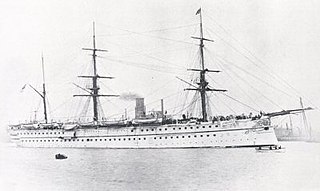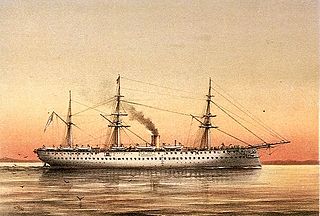Five ships of the Royal Navy have been named HMS Serapis, after the god Serapis of Hellenistic Egypt.

The first HMS Shah was a 19th-century unarmoured iron hulled, wooden sheathed frigate of Britain's Royal Navy designed by Sir Edward Reed. She was originally to be named HMS Blonde but was renamed following the visit of the Shah of Persia in 1873.

HMS Serapis was a Euphrates-class troopship commissioned for the transport of troops to and from India. She was launched in the Thames on 26 September 1866 from the Thames Ironworks and Shipbuilding Company at Leamouth, London and was the third Royal Navy ship to bear the name. She was sold in 1894.

HMS Jumna was a Euphrates-class troopship launched at Palmers Shipbuilding and Iron Company at Hebburn on 24 September 1866. She was the third vessel of the Royal Navy to carry the name.

HMS Mercury was one of two Iris-class despatch vessels, later redesignated as second class cruiser built for the Royal Navy during the 1870s. The two ships were the first all-steel warships in the Royal Navy.

HMS Himalaya was built for the Peninsular and Oriental Steam Navigation Company as SS Himalaya, a 3,438 gross register ton iron steam screw passenger ship. She was purchased by the Royal Navy in 1854 for use as a troopship until 1894 and was then moored in the Hamoaze, Devonport to serve as a Navy coal hulk until 1920, when sold off. She was sunk during a German air attack on Portland Harbour in 1940.

HMS Euphrates was an iron-hulled troopship of the Euphrates class. She was designed for the transport of British troops to India, and launched in the River Mersey on 24 November 1866 by Laird Brothers of Birkenhead. She was the fourth and last Royal Navy ship to bear the name.

HMS Crocodile was a Euphrates-class troopship launched into the Thames from the Blackwall Yard of Money Wigram & Sons on 7 January 1867. She was the fourth and last vessel of the Royal Navy to carry the name.

HMS Malabar was a Euphrates-class troopship launched in 1866, and the fifth ship of the Royal Navy to employ the name. She was designed to carry troops between the United Kingdom and British India, and was employed in that role for most of her life. She became the base ship at the Royal Naval Dockyard, Bermuda in 1897, was renamed HMS Terror in 1901 and was sold in 1918. Her name was later used as the stone frigate to which shore personnel in Bermuda were enrolled, and later for Her Majesty's Naval Base Bermuda, after the 1950s, when the dockyard was reduced to a base.

The Amazon class was a class of six screw sloops of wooden construction built for the Royal Navy between 1865 and 1866.

The Conqueror-class ships of the line were a class of two 101-gun first rate screw propelled ships designed by the Surveyor’s Department for the Royal Navy.

The Condor-class gunvessel was a class of four Royal Navy composite gunvessels of 3 guns, built between 1876 and 1877. They were all hulked or sold before 1893, giving them an active life of less than 15 years.

The Ant-class gunboat was a class of twenty-four Royal Navy flat-iron gunboats mounting a single 10-inch gun, built between 1870 and 1880. They carried no masts or sails, being among the first Royal Navy vessels not to do so. The last four vessels were ordered separately and are sometimes known as the Gadfly class, although they were essentially identical. Members of the class lingered on as steam lighters, dredgers, boom defence vessels and base ships, lasting in some cases into the 1950s.

The Sharpshooter-class torpedo gunboat was a class of torpedo gunboat built for the Royal Navy in the late 19th century. One of the class was hulked in 1904, seven were scrapped before World War I and five were converted to minesweepers. Of these minesweepers, Seagull was lost to a collision in 1918 and the rest survived the war to be broken up in the early 1920s.

The Cheerful-class gunboat was a class of twenty gunboats built for the Royal Navy in 1855 for use in the Crimean War.
The Gleaner -class gunboat was a class of six gunboats built for the Royal Navy in 1854 for use in the Crimean War.

The Dapper-class gunboat was a class of twenty gunboats built for the Royal Navy in 1854–55 for use in the Crimean War.

The Albacore-class gunboat, also known as "Crimean gunboat", was a class of 98 gunboats built for the Royal Navy in 1855 and 1856 for use in the 1853-1856 Crimean War. The design of the class, by W. H. Walker, was approved on 18 April 1855. The first vessels were ordered the same day, and 48 were on order by July; a second batch, which included Surly, were ordered in early October.

The Forester-class gunboat was a class of 4-gun composite gunboats built for the Royal Navy between 1874 and 1877. Although half had been sold by 1890, the rest survived into the 20th century as coal hulks, base vessels and other secondary uses. Foxhound survived as a hulk on the Blackwall Reach of the Thames until 1975, when she was broken up. They were built of composite construction, that is, with iron keel, stem and stern posts, and iron framing, but planked with wood.
HMS Rhadamanthus was one of the initial steam powered vessels built for the Royal Navy. On 10 January 1831 the First Sea Lord gave orders that four paddle vessels be built to competitive designs. The vessels were to be powered by Maudslay, Son & Field steam engines, carry a schooner rig and mount one or two 10-inch shell guns. Initially classed simply as a steam vessel (SV), she was re-classed as a second-class steam sloop in 1846. Designed by Thomas Roberts, the Master Shipwright of Plymouth. She was launched and completed in 1832, She was converted into a transport in 1841 then in 1851 she was a troopship and by the 1860s she was a transport again. Her breaking was completed in February 1864.


















